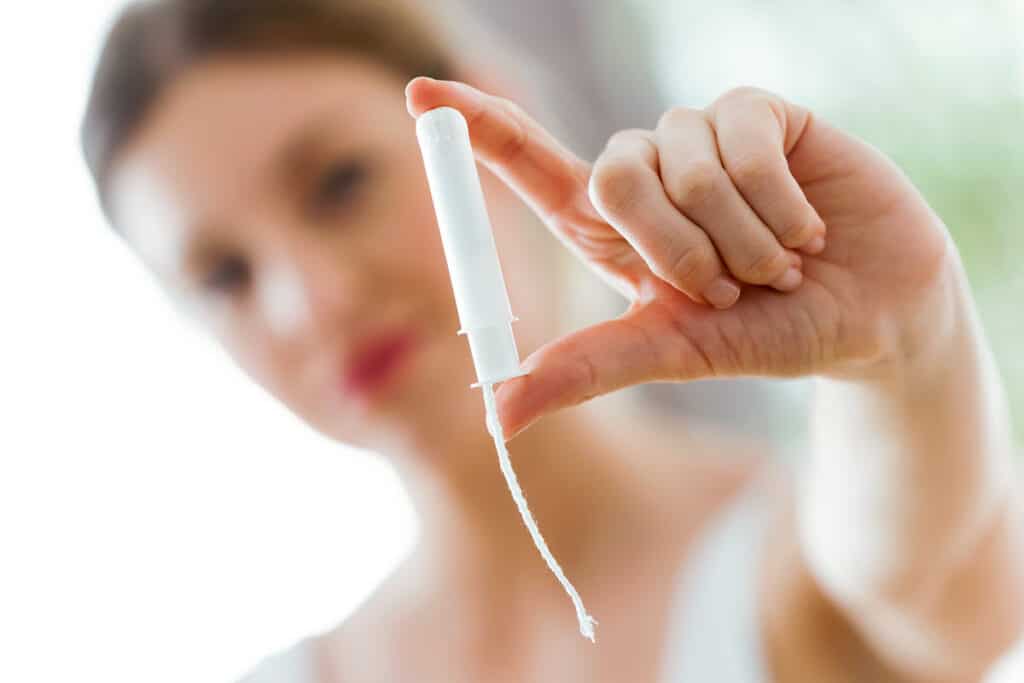Each month, women across the world change their tampons several times a day in the privacy of their home bathroom, at work in a cubicle or out and about in public conveniences. Why then, given it’s such a common activity is there so much confusion about what to do with them? Can you flush tampons?
Contents
Don’t Flush Sanitary Products
You should not flush tampons down the toilet because they can swell up and get stuck in pipes, causing blockages. Because human waste goes down the toilet too, a blockage can cause your toilet to overflow and waste to flow out over the toilet in your bathroom. Used tampons go in the general waste bin.

The question of flushing tampons is a common one, with a big split between women that say they have flushed them in the past and those that have not. According to Thames Water, 24% of people say they have flushed tampons, and over half say they do not give any thought to where they will go.
As the wider survey was not gender specific, it is unlikely that the full sample size of 2,032 participants were women, so it’s reasonable to assume that more than 24% of women have flushed their sanitary products down the toilet in the past.
The good news is that 27% of people also said that they would change their behaviour if they knew it would cause environmental damage.
Broadly speaking, a lot of tampons (and probably pads and liners too) are being incorrectly disposed of down the loo every day.
How To Dispose Of Tampons
The recommended method of throwing away used tampons is to place them into your general waste bin. Due to the nature of the products, you may wish to wrap them in the wrapper of the next tampon, or use toilet roll to disguise the appearance to discard it.
Tampons should go into the normal general waste bin at home, at work or anywhere else you change one. You can wrap them in toilet roll to make them easier to handle and appear more discreet.
Is it Okay To Flush A Tampon Once?
There will inevitably be times when you find there is no loo roll in a public toilet or there’s another reason why its hard to dispose of.
It is not okay to flush a tampon once in any event because of the risk of blockage and likelihood of environmental harm. Always place it into a bin instead, regardless of where you are.
Clogging The Toilet
While some people claim to have been flushing tampons without issue for years, blockages are more common than many people realise. Even if it clears your home’s plumbing, it may add to a sewer blockage that is gradually building.
Flushing one tampon can clog the toilet. Even if you’ve flushed them in the past without problems, sooner or later one is likely to get stuck.
How Long It Can Take For Tampons To Block Pipes
If you’ve accidentally flushed a tampon, you might be wondering if it’s got stuck on the way down the pipes as it makes its way towards a sewer.
If a tampon blocks a toilet you will usually find out within a few flushes. However, they can become lodged and gradually swell up as them absorb water, and then begin to obstruct other unpleasant waste as it travels down the pipe, taking several days to become known.
It’s a good idea to remain vigilant for several days after an accidental flush, and take great care not to do it again in case you’ve got a partial block from the tampon.
Dealing With Pipe Blockages
If a tampon has become lodged in the pipes, there are a range of possible outcomes. If you’re lucky, it might free itself, but it’s also possible that it’s completely blocking the next human waste from escaping your plumbing.
There’s no sure way to dissolve a tampon that’s stuck in your waste pipe after flushing. If your toilet is flushing slowly, call a plumber for help. Ignoring the problem could result in the toilet toilet failing to flush entirely, or worse still, waste coming back up the toilet.
If your toilet appears to be flushing as normal, you may have been lucky on this occasion. However, pay attention after each flush for a few days, as it may have partially blocked a pipe, in which case it might take time to cause a problem.
Toilets Draining Slowly
If you flush the toilet and the water level rises more than usual it’s likely you’ve got a blockage. If it doesn’t gradually drain at all, that suggest a complete block. If it slowly returns to a normal level, you likely have an obstruction that is allowing waste and flush water to pass more slowly than normal.
If your toilet is draining slowly, you are likely to have a blockage between the toilet and the sewer. Toilets slowly draining are partially blocked. If fully blocked, toilets will not drain at all.
Regardless of what is blocking your toilet, if you have any kind of blockage, it is more likely to get worse than resolve itself the longer it remains in place.
Be careful not to keep flushing the toilet if the water level is higher than usual, as the level might rise and overflow the bowl.
Seek the assistance of a plumber for help dealing with blockages. Search Google or use a service like Trusted Trader to find a reputable professional.
